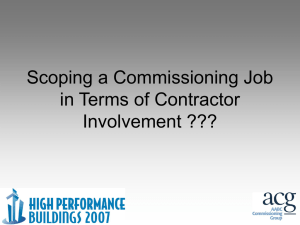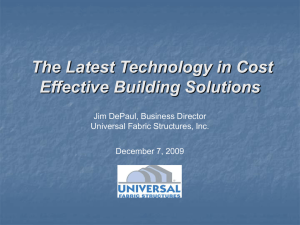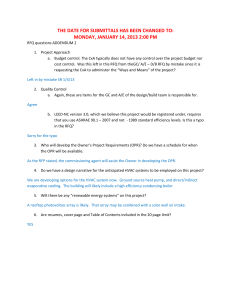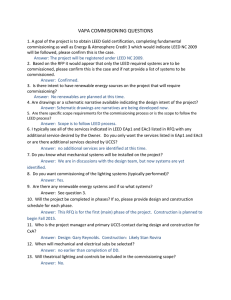Envelope Thermal Performance Factors Appendix A
advertisement
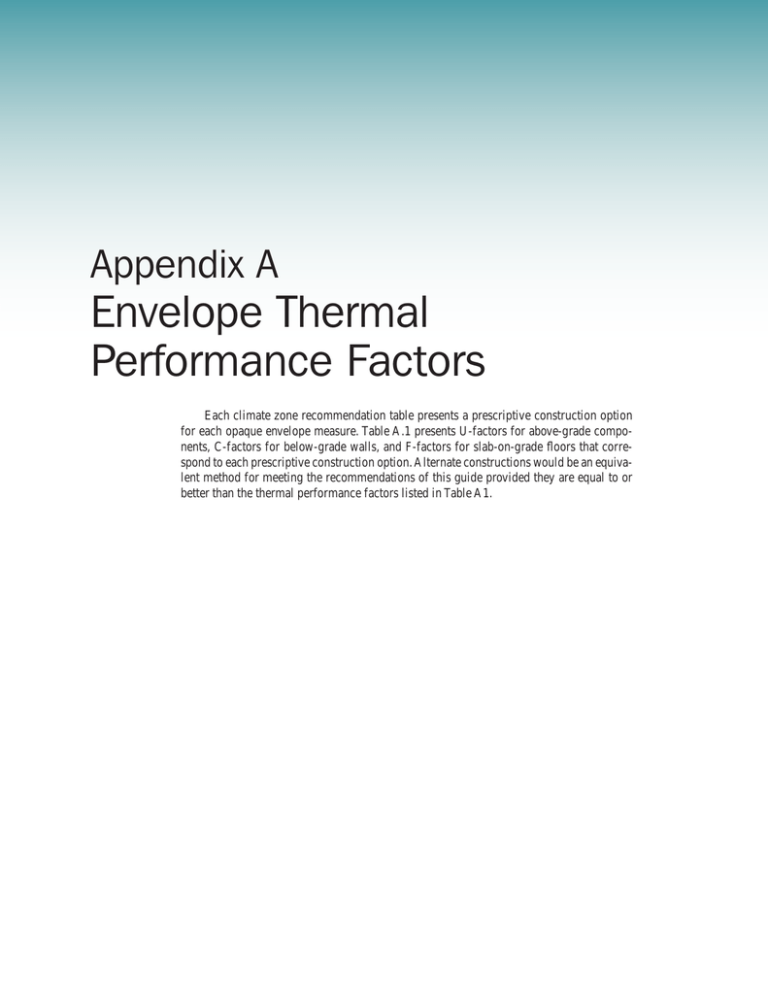
Appendix A Envelope Thermal Performance Factors Each climate zone recommendation table presents a prescriptive construction option for each opaque envelope measure. Table A.1 presents U-factors for above-grade components, C-factors for below-grade walls, and F-factors for slab-on-grade floors that correspond to each prescriptive construction option. Alternate constructions would be an equivalent method for meeting the recommendations of this guide provided they are equal to or better than the thermal performance factors listed in Table A1. 162 | Advanced Energy Design Guide for K-12 School Buildings Table A1. Envelope Thermal Performance Factors Opaque Construction Options Roof Assemblies Walls, Above Grade Insulation Entirely Above Deck Mass Walls Floors Mass R U R U R U 25 0.039 5.7 c.i. 0.151 4.2 c.i. 0.137 7.6 c.i. 0.123 6.3 c.i. 0.107 Metal Building R U 9.5 c.i. 0.104 8.3 c.i. 0.087 19 0.065 11.4 c.i. 0.090 10.4 c.i. 0.074 13+13 0.055 13.3 c.i. 0.080 12.5 c.i. 0.064 13+19 0.049 15.2 c.i. 0.071 16.7 c.i. 0.051 19+19 0.046 Metal Building Attic and Other Steel Framed R U R U 16 0.093 19 0.052 0.032 19 0.084 30 0.038 0.027 19+5.6 c.i. 0.057 38 0.032 0.017 19+11.2 c.i. 0.043 R U 30 38 60 Wood Framed and Other Steel Framed R U R U 19 0.051 13 0.124 30 0.033 13+3.8 c.i. 0.084 13+7.5 c.i. 0.064 13+21.6 c.i. 0.034 Wood Framed and Other R U Slabs Unheated R-in F 10-24 0.54 13 0.089 15-24 0.52 13+3.8 c.i. 0.064 20-24 0.51 13+7.5 c.i. 0.051 13+10 c.i. 0.045 Walls, Below Grade Below Grade Walls Heated R-in. F 7.5-12 1.02 7.5-24 0.95 10-24 0.90 R C 15-24 0.86 7.5 c.i. 0.119 15-Full 0.44 15 c.i. 0.063 Appendix B Commissioning A building can have the best possible design for achieving energy savings, but unless the building is built as designed and is operated according to the design intent, energy savings will not be achieved. A CxA ensures the energy- and water-saving methods and devices selected by the design team are incorporated in the building plans and specifications, that everything is built and tested accordingly, and that school personnel, including those occupying the building, are provided the necessary documentation and training to properly operate the building after it is occupied. The CxA can be an independent member of the design firm, the school’s facility staff, or a third-party consultant. Some prefer to use thirdparty consultants for this role to ensure that the work is done independently of the design team to ensure that the results are not biased. The Cx process is applicable to all buildings, but large and complex buildings require a correspondingly greater level of effort than is required for small, simple buildings. See Table B1 for more information. 164 | Advanced Energy Design Guide for K-12 School Buildings Table B1. Commissioning Activities and Related Responsibilities Item Activity Responsibility 1. Create Owner’s Project Requirements (OPRs) CxA/owner 2. Create project specific Cx plan (use this model, modify where necessary) Owner/CxA 3. Create the Basis of Design Architect/engineer 4. Review OPRs and Basis of Design CxA 5. Review schematic and design development documents, including load calculations CxA 6. Review construction documents before completion CxA 7. Incorporate Cx requirements into construction documents Designers 8. Review submittals for commissioned systems Designer; CxA 9. Develop project-specific construction checklists CxA 10. Implement construction checklists Contractors 11. Create and maintain Cx issues log CxA 12. Perform targeted inspections during rough-in phase CxA/AE/O&M 13. Witness pipe flushing and testing, duct testing CxA CxA/O&M 14. Field-verify contractors’ completed construction checklists 15. Performance testing and demonstrations Contractors 16. Validate test and balance report CxA 17. Conduct periodic Cx meetings CxA CxA 18. Develop functional performance test procedures 19. Assist in contractor troubleshooting CxA 20. Identify air quality issues CxA 21. Direct and witness functional performance testing CxA/O&M CxA 22. Issue final Cx report 23. Develop systems manuals from O&M manuals including re-commissioning procedures CxA 24. Project manager coordinate and document owner training performed by contractors Project manager 25. Confirm training performed by contractors is per contract and adequate CxA/O&M 26. Recommend final system acceptance CxA/O&M 27. Perform post-occupancy review two months after occupancy CxA/project manager/ facilities personnel/O&M 28. Perform post-occupancy review and warranty inspections 10 months after occupancy per contract documents CxA/project manager/ facilities personnel/ O&M/architect 29. Create lesson-learned document for distribution to all project managers/planners CxA Note: Designer is an inclusive term that indicates project architect and engineers and other design consultants, such lighting, acoustics, landscape architects. Appendix C Climate Zones for Mexico and Canada The following tables show the climate zone numbers for a wide variety of Mexican and Canadian locations. Additional information on international climatic zones can be found in ASHRAE Standard 90.1-2004, Normative Appendix B, “Building Envelope Climate Criteria.” The information is from Tables B-2 and B-3 in that appendix. Table C1. Mexican Climate Zones Country City Country Zone City Mexico Zone Mexico Mexico City (Distrito Federal) 3 Tampico (Tamaulipas) 2 Guadalajara (Jalisco) 1 Veracruz (Veracruz) 4 Monterrey (Nuevo Laredo) 3 Merida (Yucatan) 1 166 | Advanced Energy Design Guide for K-12 School Buildings Table C2. Canadian Climatic Zones Province City Province Zone City Alberta (AB) Province Zone Newfoundland (NF) City Zone Prince Edward (PE) Calgary International Airport (A) 7 Corner Brook 6 Charlottetown A 6 Edmonton International A 7 Gander International A 7 Summerside A 6 Grande Prairie A 7 Goose A 7 Jasper 7 St John’s A 6 Lethbridge A 6 Stephenville A 6 Medicine Hat A 6 Red Deer A 7 British Columbia (BC) Northwest Territories (NW) Quebec (PQ) Bagotville A 7 Drummondville 6 Granby 6 Ft Smith A 8 Montreal Dorval Int’l A 6 Inuvik A 8 Quebec A 7 Yellowknife A 8 Rimouski 7 Septles A 7 Shawinigan 7 Dawson Creek A 7 Ft Nelson A 8 Kamloops 5 Nanaimo A 5 Halifax International A 6 Sherbrooke A 7 New Westminster BC Pen 5 Kentville CDA 6 St Jean de Cherbourg 7 Penticton A 5 Sydney A 6 St Jerome 7 Prince George 7 Truro 6 Thetford Mines 7 Prince Rupert A 6 Yarmouth A 6 Trois Rivieres 7 Vancouver International A 5 Val d’Or A 7 Victoria Gonzales Hts 5 Valleyfield 6 Nova Scotia (NS) Nunavut Resolute A 8 Manitoba (MB) Saskatchewan (SK) Ontario (ON) Brandon CDA 7 Estevan A 7 Churchill A 9 Belleville 6 Moose Jaw A 7 Dauphin A 7 Cornwall 6 North Battleford A 7 Flin Flon 7 Hamilton RBG 5 Prince Albert A 7 Portage La Prairie A 7 Kapuskasing A 7 Regina A 7 The Pas A 7 Kenora A 7 Saskatoon A 7 Winnipeg International A 7 Kingston A 6 Swift Current A 7 London A 6 Yorkton A 7 New Brunswick (NB) North Bay A 7 Chatham A 7 Oshawa WPCP 6 Fredericton A 6 Ottawa International A 6 Moncton A 6 Owen Sound MOE 6 Saint John A 6 Petersborough 6 St Catharines 5 Sudbury A 7 Thunder Bay A 7 Timmins A 7 Toronto Downsview A 6 Windsor A 5 Yukon Territory (YT) Whitehorse A 8 Appendix D Energy Star® Appliances The following equipment and appliances that are typically used in K-12 schools and are within the scope of the applicable Energy Star program will have the ENERGY STAR label. For more information, visit the ENERGY STAR Web site at www.energystar.gov. 1. Appliances • battery chargers • clothes washers • dehumidifiers • dishwashers • refrigerators and freezers • room air conditioners • room air cleaners • water coolers 2. Heating and Cooling • air-source heat pumps (see also the energy-efficiency requirements in Chapter 3) • boilers (see also the energy-efficiency requirements in Chapter 3) • central air conditioners (see also the energy-efficiency requirements in Chapter 3) • ceiling fans • dehumidifiers • furnaces (see also the energy-efficiency requirements in Chapter 3) • geothermal heat pumps (see also the energy-efficiency requirements in Chapter 3) • programmable thermostats • room air conditioners • ventilating fans 3. Electronics • cordless phones • combination units (TV/VCR/DVD) • DVD products • audio 168 | Advanced Energy Design Guide for K-12 School Buildings • • televisions VCRs 4. Office Equipment • computers • copiers • fax machines • laptops • mailing machines • monitors • multifunction devices • printers • scanners 5. Lighting • CFLs • ceiling fans 6. Commercial Food Service • commercial fryers • commercial hot food holding cabinets • commercial solid door refrigerators and freezers • commercial steam cookers 7. Other Products • traffic signals • transformers • vending machines Appendix E Additional Resources Organizations—General American Institute of Architects (AIA) 1735 New York Ave., NW Washington, DC 20006-5292 800-AIA-3837 or 1-202-626-7300 http://www.aia.org/ American Society of Heating, Refrigerating and Air-Conditioning Engineers (ASHRAE) 1791 Tullie Circle, NE Atlanta, GA 30329 800-527-4723 or 1-404-636-8400 http://www.ashrae.org/ ASHRAE Standing Standards Project Committee 90.1 (SSPC 90.1) ASHRAE Technical Committee on Educational Facilities (TC 9.7) Illuminating Engineering Society of North America (IESNA) 120 Wall Street, Floor 17 New York, NY 10005 1-212-248-5000 http://www.iesna.org/ U.S. Department of Energy (DOE) 1000 Independence Ave., SW Washington, DC 20585 800-dial-DOE (1-800-342-5363) or 1-202-586-5000 http://www.energy.gov/ 170 | Advanced Energy Design Guide for K-12 School Buildings U.S. Green Building Council (USGBC) 1800 Massachusetts Ave., NW, Suite 300 Washington, DC 20036 800-795-1747 or 202-742-3792 http://www.usgbc.org/ Organizations—High Performance Schools Collaborative for High Performance Schools (CHPS) 142 Minna Street, Second Floor San Francisco, CA 94105 887-642-CHPS http://www.chps.net/ National Clearinghouse for Educational Facilities (NCEF) 1090 Vermont Ave., NW, Suite 700 Washington, DC 20005-4905 888-552-0624 or 202-289-7800 http://www.edfacilities.org/ National Institute of Building Sciences (NIBS) 1090 Vermont Ave., NW, Suite 700 Washington, DC 20005-4905 202-289-7800 http://www.nibs.org/ Sustainable Building Industry Council (SBIC) 1112 16th Street, NW, Suite 240 Washington, DC 20036 202-628-7400 http://www.sbicouncil.org/ Commissioning CHPS. 2004. Best practices manual, Volume V—Commissioning. Collaborative for High Performance Schools, San Francisco (www.chps.net). ASHRAE. 2005. ASHRAE Guideline 0-2005, The Commissioning Process. Atlanta: American Society of Heating, Refrigerating and Air-Conditioning Engineers, Inc. ASHRAE. 1996. ASHRAE Guideline 1-1996, The HVAC Commissioning Process. Atlanta: American Society of Heating, Refrigerating and Air-Conditioning Engineers, Inc. NIBS. 2005. ASHRAE Guideline 3-2005, Exterior Enclosure Technical Requirements for the Commissioning Process. Washington, DC (www.wbdg.org). NCEF. n.d. Resource lists—School building commissioning. www.ncef.org. Appendix E—Additional Resources | 171 High Performance Schools Eley, C. 2006. High performance school characteristics. ASHRAE Journal 48(5):60–6. Operations and Maintenance ASBO International. 2003. Planning guide for maintaining school facilities. National Forum on Education Statistics, School Facilities Maintenance Task Force, Association of School Business Officials International, Washington, DC (http://nces. ed.gov/pubs2003/2003347.pdf). ASHRAE. 1993. Preparation of Operational Maintenance Documentation for Building Systems. Atlanta: American Society of Heating, Refrigerating and Air-Conditioning Engineers, Inc. ASHRAE. 2007. ASHRAE Handbook—HVAC Applications. Chapter 38, “Operation and Maintenance Management.” Atlanta: American Society of Heating, Refrigerating and Air-Conditioning Engineers, Inc. CHPS. 2004. Best Practices Manual, Volume IV—Maintenance and Operation (M&O). Collaborative for High Performance Schools, San Francisco (www.chps.net). DOE. 2004. School operations and maintenance: Best practices for controlling energy costs—A guidebook for K-12 school system business officers and facilities managers. U.S. Department of Energy, Washington, DC. (http://www.ase.org/uploaded_files/ greenschools/School%20Energy%20Guidebook_9-04.pdf). Zero Energy Torcellini, P., and D. Crawley. 2006. Understanding zero-energy buildings. ASHRAE Journal 48(9):62–9. Torcellini, P., S. Pless, M. Deru, and D. Crawley. 2006. Zero energy buildings: A critical look at the definition. Proceedings of the ACEEE Summer Study on Energy Efficiency in Buildings, Pacific Grove, CA.
